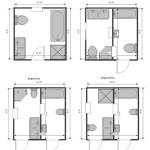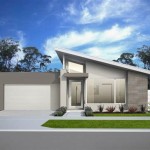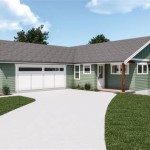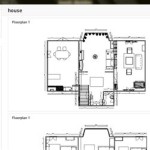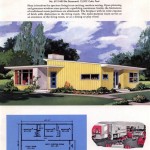Single Pitch Roof House Plans: Design, Benefits, and Considerations
Single pitch roof house plans, also known as shed roof designs, are increasingly popular for modern homes due to their sleek aesthetics, functional advantages, and potential cost-effectiveness. These roofs slope in one direction, creating a distinctive architectural statement that can seamlessly integrate with both contemporary and minimalist designs. Understanding the nuances of single pitch roof construction, design considerations, and potential benefits is crucial for homeowners and builders considering this style.
The defining characteristic of a single pitch roof is its singular, angled plane. This contrasts with gable roofs, which have two sloping sides meeting at a ridge, or hip roofs, which feature slopes on all four sides. Single pitch roofs are often incorporated into modern architectural styles, allowing for large windows and open floor plans due to the simplified structural design. While the visual appeal is a primary draw, the functional attributes of a single pitch roof also warrant consideration.
The design flexibility offered by single pitch roof plans allows for a wide range of architectural interpretations. From small, efficient cabins to expansive, multi-story residences, the single pitch roof can adapt to various spatial requirements and aesthetic preferences. Careful planning and consideration of site orientation are essential to maximize the benefits of this design, particularly in terms of natural light and energy efficiency.
Key Point 1: Structural Advantages and Cost-Effectiveness
One of the principal advantages of single pitch roofs lies in their relatively simple construction. Compared to more complex roof designs, such as hip or mansard roofs, single pitch roofs require fewer materials and less intricate framing. This simplification translates to lower labor costs and potentially faster construction timelines, making them an attractive option for budget-conscious homeowners and developers.
The straightforward design also facilitates drainage. Rainwater and snow melt flow directly off the roof in a single direction, minimizing the risk of water ponding and subsequent leaks. This simplified drainage system can also reduce the need for complex gutter systems and downspouts, further contributing to cost savings and reduced maintenance.
However, it's important to note that the structural integrity of a single pitch roof is paramount. Proper engineering and construction are crucial to ensure that the roof can withstand wind loads, snow loads, and other environmental stressors. The steeper the pitch, the greater the wind resistance, but also the greater the potential for wind uplift. Consulting with a qualified structural engineer is essential to determine the optimal pitch and framing design for the specific geographic location and climate.
The material selection for a single pitch roof can also influence its cost-effectiveness and longevity. Options range from traditional asphalt shingles to metal roofing, tile, and even green roofs. Metal roofing, while potentially more expensive upfront, offers superior durability and longevity, often lasting 50 years or more. Green roofs, consisting of a layer of vegetation, provide insulation, reduce stormwater runoff, and enhance the aesthetic appeal of the structure, but require specialized structural support and maintenance.
Furthermore, the simplicity of a single pitch roof can facilitate the installation of solar panels. The unobstructed surface provides an ideal platform for maximizing solar energy capture, contributing to long-term energy savings and reducing reliance on conventional power sources. The southern exposure of a single pitch roof is particularly advantageous for solar panel installation in the northern hemisphere.
Key Point 2: Design Considerations for Natural Light and Ventilation
The orientation of a single pitch roof significantly impacts the amount of natural light that enters the building. By orienting the high side of the roof towards the south (in the northern hemisphere), homeowners can maximize passive solar gain during the winter months, reducing heating costs. Conversely, orienting the high side to the north can minimize direct sunlight exposure during the summer, helping to keep the interior cooler.
Clerestory windows, strategically placed along the high side of the roof, can further enhance natural light penetration. These windows allow sunlight to enter high above the floor, providing diffused, ambient light that reduces the need for artificial lighting. Clerestory windows also contribute to improved ventilation, allowing warm air to rise and escape, promoting natural airflow throughout the building.
The pitch of the roof also plays a role in controlling sunlight exposure. Steeper pitches allow for more direct sunlight to enter during specific times of the day, while shallower pitches provide more diffused light. Careful consideration of the roof pitch and window placement is essential to achieve the desired balance between natural light and thermal comfort.
Ventilation is another critical design consideration. Adequate ventilation helps to prevent moisture buildup, reduce the risk of mold growth, and improve indoor air quality. Single pitch roofs can be designed with strategically placed vents along the high and low sides to promote natural airflow. Gable vents, ridge vents, and soffit vents are common options that can be incorporated into the design.
The use of overhangs can also help to regulate sunlight exposure and provide shade during the summer months. Overhangs extend beyond the exterior walls, blocking direct sunlight from entering windows and reducing heat gain. The depth of the overhang should be carefully calculated based on the orientation of the building and the angle of the sun.
Key Point 3: Aesthetic Versatility and Architectural Integration
Single pitch roofs offer a wide range of aesthetic possibilities, making them suitable for various architectural styles. They can be seamlessly integrated into modern, minimalist, and contemporary designs, adding a touch of sophistication and visual interest. The clean lines and simple geometry of a single pitch roof complement minimalist aesthetics, creating a sleek and uncluttered appearance.
The angle of the roof pitch can significantly influence the overall aesthetic. A steep pitch creates a dramatic, angular silhouette, while a shallow pitch provides a more subtle and understated look. The choice of roofing material also contributes to the aesthetic appeal. Metal roofing offers a modern, industrial aesthetic, while wood shingles provide a more traditional and rustic look.
Single pitch roofs can be combined with other architectural elements to create unique and visually appealing designs. For example, a single pitch roof can be paired with large expanses of glass to create a light-filled and airy interior. It can also be combined with natural materials, such as wood and stone, to create a warm and inviting atmosphere.
The integration of a single pitch roof with the surrounding landscape is also an important consideration. The roof can be designed to complement the natural contours of the site, creating a harmonious relationship between the building and its environment. Green roofs can further enhance this integration, blurring the boundaries between the built and natural worlds.
Furthermore, single pitch roofs can be used to create dynamic and asymmetrical compositions. By combining multiple single pitch roofs at different angles and elevations, architects can create visually stimulating and spatially complex designs. This approach allows for greater flexibility in accommodating diverse functional requirements and aesthetic preferences.
In conclusion, single pitch roof house plans represent a versatile and increasingly popular option for modern homeowners and builders. Their structural advantages, potential cost-effectiveness, and aesthetic versatility make them a compelling choice for a wide range of architectural styles and spatial requirements. Careful consideration of site orientation, material selection, and ventilation strategies is essential to maximize the benefits of this design and create a sustainable and aesthetically pleasing living environment.

Modern House Plans Single Pitch Roof Shed

8 Single Pitch Roof Ideas Pitched House

Single Sloped Roofs Ramp Up Modern Homes

Slanted Single Pitch Shed Roof House Plans Floor

Single Slope Roof Patio Roofs Shed Modern Design Contemporary Exterior Eco House

16 Examples Of Modern Houses With A Sloped Roof

Buy Single Roof House Plan Eplan

Plan 42902 Modern House With Low Slope Roof

7 Single Slope Roof Home Plans Ideas House Design

Modern And Cool Shed Roof House Plans Houseplans Blog Com



